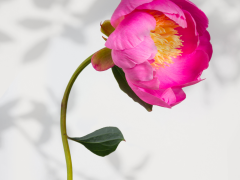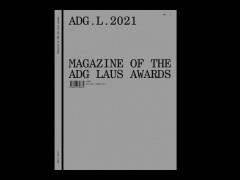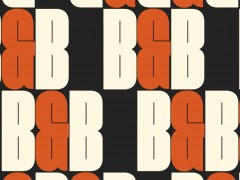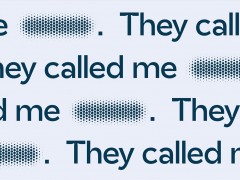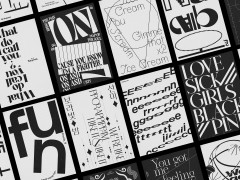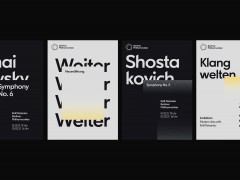Lara Captan on the beauty and the many challenges of Arabic type design
On the occasion of this year’s Justin Howes Memorial Lecture “Investigatory Explorations & Experimentations in Arabic Type” by Lara Captan at St Bride Foundation, Typeroom interviews the independent type designer & typographer based in Amsterdam on all things Arabic.
Captan, a researcher & practitioner who strives to provide alternative pathways to designing Arabic typefaces -both in form and technology- aims to spread the word and the beauty of this non-Latin script that is gaining a long-overdue momentum. Here she explains why and how Arabic type design will gain its place in an industry flooded with Latin.
“My interest in Arabic type started when I was doing my undergraduate studies in Graphic Design at the American University of Beirut (2002–2006)” Captan says Typeroom.
“We learned to typeset both Latin and Arabic texts since we use both scripts in Lebanon. And even as inexperienced students in design, we used to see very clearly how well-crafted Latin typefaces were and how Arabic typefaces do not reach anywhere near the level of quality of Latin fonts. But nobody would tell us why. So, I had a calling. I made it my life mission to understand why Arabic typefaces were in the state they were 15 years ago and what more people and I can do about it. I felt the need to honor my cultural heritage and participate in giving it a contemporary and authentic visual voice.”
TR: Recently the interest in non-Latin scripts has gained momentum. Are young type designers interested in Arabic typography?
LC: Yes, we also see a growing interest in Arabic type design from natives and non-natives. Arabic is one of the most widely used scripts globally, so I think that’s why the field is so appealing.
TR: Which would you consider the most pivotal moment in Arabic type design history?
LC: It was in the 1730s when the printing press was adopted using Arabic script natively—even though I would ideally think natives should have invented another machine. The printing press arrived in the Middle East about 200 years after non-natives had been cutting Arabic fonts. I highlight this particular moment in history because I believe that, until recently, many fonts cut for the printing press in places like Istanbul or Cairo were far better in quality than many of the digital Arabic typefaces available until not so long ago.
TR: What is the state of the Arabic type design industry now?
LC: I think we’re in a good place nowadays. It still feels like the more exciting times of even higher quality typefaces are yet to come, but there are more and more Arabic type designers from different parts of the world who create more and more diverse and experimental typefaces. There is a growing demand for custom type and an ever-increasing supply and demand for retail type. There are also more researchers in aspects of history which helps to deeper understand the past and the issues at hand and move forward insightfully.
TR: Has technology and digital means helped in bringing a more authentic take on Arabic letterforms?
It depends on the technology and the designer. Widespread digital type technologies provide far more options to create more original forms than a Linotype machine has or even earlier digital type technologies. Fonts are finally rendered correctly (without attached glyphs detaching suddenly or the not defined glyph appearing all over Arabic text in a browser – although these phenomena still happen). There are still foundational constraints: the architecture of type technology uses the architecture of the printing press, meaning that letters are “shipped” in a box with vertical limits, and there is one character per box unless it’s a ligature. For Latin, that works fine. It just does not work with the natural script behavior for other scripts. However, with the knowledge of the constraints and some added tools/programming, designers can bypass many foundational issues and make the typefaces they imagine.
TR: What’s your take on the so-called “simplified Arabic” typefaces available?
LC: I used to get angry even thinking about them! However, thanks to Titus Nemeth’s book Arabic Type-Making in the Machine Age: The Influence of Technology on the Form of Arabic Type, 1908–1993, I now empathize with their reason for being, and I’m glad this phase of history is nearly over.
TR: How many fonts are available for Latin and how many for the Arabic language?
LC: I’m not sure of the accurate data, but I would hypothesize many hundreds of thousands in Latin and perhaps hundreds or a thousand or two in Arabic, of which only a handful are used.
TR: Has the Westernization of Arabic letters damaged the true spirit of the Arabic script?
LC: Type and language could be seen as representations of a community’s present state: What do they look up to? Which cultures do they admire? How do they want to present themselves to the world? Is their language still being written? Is it still necessary to write it and use it? How strongly do they hold on to their national or communal identity -if they have one? In that light, there are positive and negative impacts on adopting visual processes from another culture.
In the case of Arabic script, I think it was a phase where global brands had to adapt to local markets, where many Arabic-scripted nations were in admiration of the West, so Arabic gave some of its spirit away to Western principles of form -and an x-height in a script with no letter “x”. To me, the designers who created these fonts were in a search for modernity in Arabic in a direction that lacked in-depth knowledge and understanding of the Arabic script. It lacked creativity, and drawing skills and these fonts were a quick and easy expression of a modernity that is closely associated with geometry and modularity. But most probably, this phase of Arabic-type design history was also an inevitable steppingstone into the present and the future.
TR: What is the most challenging aspect of Arabic type design?
LC: There are so many. It’s hard to choose! I guess if I can cram everything into one complicated question, my main challenge would be: How to create Arabic typefaces that are deeply aware of every design decision made in every curve, shape, feature, all the while balancing between authenticity, contemporaneity, and market needs, both on a formal and technical level?
TR: What inspired you to launch the Arabic Type Design - Beirut program along with Kristyan Sarkis?
LC: We felt the need to share our knowledge with others. Like most Arabic type designers, we are self-taught; there is no educational program you can attend to become an Arabic type designer. In some way, this also means we have a lot of freedom. But the downside is that it takes a lot of time before we can access enough information and make enough type explorations to start creating decent quality typefaces. So we wanted to offer designers a solid foundation based on which they could more easily pursue their dreams.
Personally, I attended the Type@Cooper Condensed program in New York, which inspired me to start ATDB. That program helped me so much in my career; I was hoping ATDB could do the same for aspiring Arabic Type Designers.
TR: What are your hopes for Arabic typography in the future?
LC: I hope that the Arabic script remains in use for many centuries to come, and that future generations of Arabic-type designers can do fantastic work that makes readers and designers happy and proud to use the script to its full potential. And I hope that type technology will evolve more to support many of the scripts of the world and their subtleties without the need for significant concessions.
TR: Is the type design industry inclusive enough?
LC: The type industry is no different from most other industries globally. There are a lot more efforts to make for inclusivity in the workplace, but for that, I believe we globally and locally need to address the many sources of the problem(s). To answer your question a bit more specifically, I will speak as a Lebanese woman in type who works and lives in The Netherlands.
Type is a dialogue between design and technology. On an economic level, a person who wants to become a type designer needs to read and write English, attend some form of design education, operate and own a computer, may need to buy type design software, and especially have the luxury to make a lot of time in between work to create typefaces. And then, one must have the opportunity, skill, network, etc., to be able to sell one’s typefaces.
On the social level, I’m lucky that my parents are open-minded human beings who gave me equal chances in life as a man would have in my culture. If I had “landed” in a different family, this could have been different. (I apologize for the binary terms; the binary is still the norm in my country.) In the Netherlands, there is quite a big pool of different types of practitioners of different ethnicities, genders, and script interests. I believe the Type and Media program at the KABK attracts many people here, and the Netherlands is also a considerably tolerant place in general. The only catch is that for non-Europeans, people must find a way to stay on European territory.
Lastly, when it comes to the type industry, there have been growing efforts to have more women speak at conferences so the industry is becoming more and more diverse -in all the senses of the word. Having said that, there is still plenty of room for inclusion in the world, in general.
Explore Lara Captan’s work here.
Tags/ typography, typefaces, arabic type, lecture, st bride foundation, lara captan

